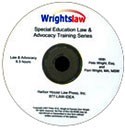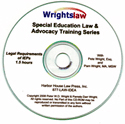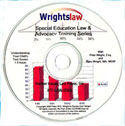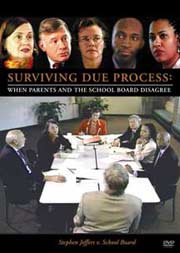|
|
When IDEA was reauthorized in 2004 some new buzz words emerged. One term is Response to Intervention (RTI). Although response to intervention is not actually new, it is very new to IDEA, parents, and to many school districts.
Susan Bruce has created a Parent's Guide to Response to Intervention that highlights important RTI issues parents need to be aware of.
Susan is the mother of three children with learning disabilities, a parent advocate, and Region 3 Regional Education Coordinator for her Parent Information and Training Center, PRO*Parents of South Carolina, Inc.
Susan says, "RTI, if used as intended, can be a significant advance in special education. If used incorrectly, RTI will prevent students who have true learning disabilities from receiving the specialized instruction they need.
As with any special educational issue that affects our children. we parents must become experts on RTI. We must educate ourselves, ask questions, and document what we are told."
In this issue of the Special Ed Advocate, Susan discusses RTI issues, benefits, and concerns. The parent guide explains the RTI process and what IDEA requires, parent concerns and important questions about RTI, and what RTI means for our kids.
Please don't hesitate to forward this issue to other families, friends, and colleagues.

Sign up free today! l Read previous issues |
|
RTI and Hope for Better Instruction |
RTI in IDEA and “scientifically research based instruction” in both IDEA and NCLB, emphasizes the quality of instruction used with ALL children. NCLB and IDEA raise the bar in education by attempting to ensure that ALL children receive high quality instruction.
The purpose of RTI is to catch struggling children early, provide appropriate instruction, and prevent the need to refer the child for special education. This concept offers hope and fear in advocates and parents.
RTI offers hope that all children will receive better and more adequate instruction in math and reading. RTI provides a new and different way to identify students with specific learning disabilities. But, there are important issues that parents need to be aware of. If we, as parents, are not educated on the RTI process and what IDEA requires, our schools may fail to identify some children who do have specific learning disabilities.
I concur with the experts who say that many children have not received the type of instruction they need to be successful. The regular education core curriculum often leaves out one or more of the five essential components required for effective reading instruction by the National Reading Panel. When used as intended, RTI should eliminate this problem. |
back to the top |
|
What is RTI? |
RTI is a tiered process of instruction that allows schools to identify struggling students early and provide appropriate instructional interventions. Early intervention means more chances for success and less need for special education services. RTI would also address the needs of children who previously did not qualify for special education.
RTI Should be a School Wide Model
Although each school’s model may look different, there are several essential and necessary components that parents need to be aware of:
-
-
School Wide Screening
-
-
Fidelity
-
Procedural Safeguards
Read more about what RTI can mean for our kids in A Parent's Guide to Response to Intervention.
RTI Tiers
RTI is a delivered to students in tiers or levels. There is much discussion about how many tiers should be in RTI models. The three-tiered model is the most common. This means there are different levels of intervention, based on the needs of the student. The level of intervention increases in intensity if a child does not respond to instruction.
IDEA does not specify how many tiers an RTI model must contain. IDEA does not specify how long a child must remain in one tier before moving to the next level. The US Department of Education has left this to the states to determine.
What RTI is NOT
-
Special seating in classroom
-
Shortened assignments
-
Parent-teacher conferences
-
Suspension
-
Retention
-
“More of the same” general classroom instruction
|
back to the top |
|
What IDEA Says about RTI and Specific Learning Disabilities (SLD) |
Section 300.307 of the federal Special Education Regulations says that states must adopt criteria for determining whether a child has a specific learning disability. States must not require the use of a severe discrepancy between intellectual ability and achievement model. States must permit the use of a process based on the child's response to scientific, research-based intervention.
When IDEA was reauthorized in 2004, RTI was added in an attempt to bring IDEA in line with NCLB and Reading First. In the Commentary to the Regulations, US DOE acknowledged that identification “models that incorporate RTI represent a shift in special education toward goals of better achievement and improved behavioral outcomes for children with specific learning disability (SLD).” |
back to the top |
|
Concerns about the RTI Process |
I agree with the experts who say that many children are identified with specific learning disabilities because they do not receive adequate instruction in reading and math. In other words, these children are not making sufficient progress because they receive poor instruction, not because they have a learning disability.
I also believe some children have specific learning disabilities.
RTI Should Not Delay a Necessary Evaluation
My fear is that school districts may use RTI as an excuse to delay, or worse, to not evaluate children suspected of having specific learning disabilities.
In the Commentary to the federal regulations, many people expressed these same concerns.
US Department of Education added language to the federal regulations to ensure that parents are notified of their right to request an evaluation at any time. |
back to the top |
|
Accurate Identification? Appropriate Instruction? Ask These Questions! |
 The Commentary to the federal regulations (p.46646-46647) describes what the Essential Components of Reading Instruction are and references what the ESEA (NCLB) says about appropriate reading instruction including: Phonemic Awareness, Phonics, Vocabulary Development, Reading Fluency, Reading Comprehension Skills. The Commentary to the federal regulations (p.46646-46647) describes what the Essential Components of Reading Instruction are and references what the ESEA (NCLB) says about appropriate reading instruction including: Phonemic Awareness, Phonics, Vocabulary Development, Reading Fluency, Reading Comprehension Skills.
When should a parent be notified of their right to request an evaluation?
In general , when the child moves from a tier 1 general education (class wide intervention) to a tier 2 (more targeted small group interventions), parents should be informed about what is happening and their rights.
Parents should be advised that their child is not making expected academic progress, the services that will be provided and strategies used to increase their child's progress, and other options that are available to them i.e., the right to request an evaluation under IDEA at any time.
There are specific questions parents should ask to ensure that their child will be accurately identified, and is receiving appropriate instruction to begin with.
-
How many tiers are included the RTI model?
-
How long will my child remain in a tier before moving to the next tier?
-
What scientifically research based form of instruction will the teacher use?
-
What documentation demonstrates the effectiveness of the program?
-
What education journal documents this form of instruction as “peer reviewed”?
-
Does the reading program include the elements defined as "essential components of an effective reading program" set forth by the National Reading Panel ?
-
How often will the school monitor my child's progress?
-
What type of progress monitoring will the school use?
- ...more in the Parent's Guide to RTI
Read Susan's Success Story about charting the numbers on test results. From Victim to a Mighty Force: The Numbers Do Not Lie. |
back to the top |
|
|







 The
The 


